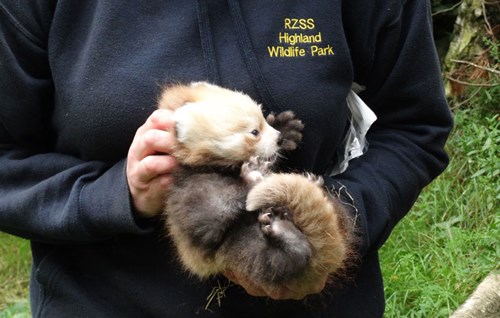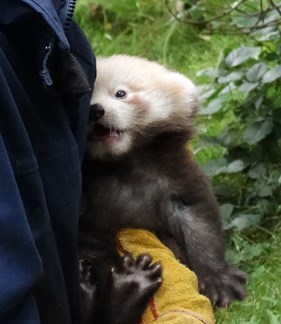Red Panda Kits Pass Their Examinations
07/08/2017 in Highland Wildlife Park

* Photos by Jan Morse / RZSS
On 14 June, our female red panda Kitty gave birth to her third litter of kits. As with all carnivore births at RZSS Highland Wildlife Park, the keepers took a step back from much of the routine husbandry so as to give Kitty and her new litter more privacy and less potential disturbance. When it comes to the successful captive rearing of baby carnivores, it is definitely a case of less is more.
As with Kitty’s previous litters we have waited until the youngsters were a bit older before examining the kits more closely. In late July when the youngsters were just over 6 weeks old, the keepers and our vet went in and gently lifted them out of the nest box for their initial checks. This process is done quickly and quietly so as not to stress mum or the youngsters too much, but as it happens, Kitty was off feeding in another area of the enclosure.
 When they are lifted out of the nest box a rapid health assessment is undertaken to make sure they appear healthy have all their toes, a tail and are a good weight. During this examination their sex is determined, which allows for two very different things to happen. We inform the breeding programme coordinator so that he or she has plenty of time to decide on where they should eventually go and with whom they should be paired. Knowing the sex also allows the keepers to come-up with a gender appropriate name. Before returning the kits to the nest boxes, they each have a small microchip inserted under their skin, using a special type of syringe, so that they can be easily and accurately identified at any point in the future. These microchips are the same as the ones that you need to put into your dog and should put into your cat. After the microchipping, the kits are placed back into the nest box and the staff quickly and quietly leave the enclosure.
When they are lifted out of the nest box a rapid health assessment is undertaken to make sure they appear healthy have all their toes, a tail and are a good weight. During this examination their sex is determined, which allows for two very different things to happen. We inform the breeding programme coordinator so that he or she has plenty of time to decide on where they should eventually go and with whom they should be paired. Knowing the sex also allows the keepers to come-up with a gender appropriate name. Before returning the kits to the nest boxes, they each have a small microchip inserted under their skin, using a special type of syringe, so that they can be easily and accurately identified at any point in the future. These microchips are the same as the ones that you need to put into your dog and should put into your cat. After the microchipping, the kits are placed back into the nest box and the staff quickly and quietly leave the enclosure.
The kits both proved to be male and were subsequently named N’mai and Nam Pang after rivers in northern and eastern Myanmar. This follows in the tradition of all of our red pandas born at the Park being named after geographical features in and around the species’ wild range.
Red pandas are currently classified as endangered on the IUCN Red List, with the main threats being hunting and habitat loss due to timber extraction and agriculture. A healthy captive population is an important part of the conservation efforts to safeguard this species. The information gathered during the examinations, including notes of all the procedures, are entered into each individual red panda’s computerised record. These records are shared with over 1,000 zoological collections in over 90 countries worldwide that in turn contribute their own animal data to this online database. Without comprehensive and accurate information on all our animals at the Park and other zoos, our coordinated breeding programmes would be completely ineffective and anyone conducting research on the species would be missing vital data that allows for accurate analysis.
Of course, as gentle and quick as the keepers were, the young panda kits wriggled and most likely thought the whole process was a mildly unpleasant intrusion into their busy schedule of feeding from mum and sleeping!
Now tucked away back in their nest box, visitors to the Park can expect to see the kits around September, when they will begin venturing out of the den.
Douglas Richardson
Head of Living Collections at RZSS Highland Wildlife Park
Featured Articles

An update from the Budongo Forest
19/04/2024 in Conservation

Edinburgh Zoo named best zoo in Scotland
15/04/2024 in Edinburgh Zoo

























Follow EZ